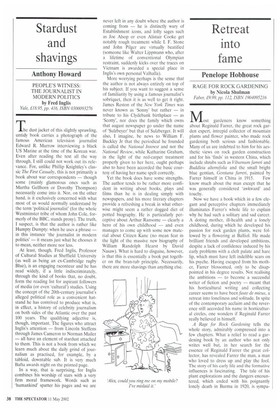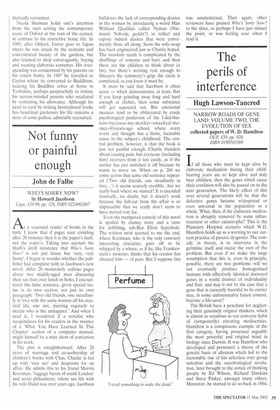Retreat into fame
Penelope Hobhouse
RAGE FOR ROCK GARDENING by Nicola Shulman Faber, £9.99, pp. 112, ISBN 1904095216 Most gardeners know something about Reginald Farrer, the great rock garden expert, intrepid collector of mountain plants and flower painter, who made rock gardening both serious and fashionable. Many of us are indebted to him for his aesthetic views on rock garden construction and for his 'finds' in western China, which include shrubs such as Viburnum farreri and Buddleia alternifolia and the small bright blue gentian, Gentiana fatreti, painted by
Farrer himself in China in 1915. Few know much about the man except that he was generally considered 'awkward' and touchy.
Now we have a book which in a few elegant and perceptive chapters immediately illuminates Farrer's whole life to explain why he had such a solitary and sad career. A doting mother, ill-health and a lonely childhood, during which he developed his passion for rock garden plants, were followed by a flowering at Balliol. He made brilliant friends and developed ambitions, despite a lack of confidence induced by his early problems with a cleft palate and hare lip, which must have left indelible scars on his psyche. Having escaped from his mother, Farrer blossomed, only to be disappointed in his degree results. Not realising the ambitions — to become a successful writer of fiction and poetry — meant that his horticultural writing and collecting career seems to have been faute de mieux, a retreat into loneliness and solitude. In spite of the contemporary acclaim and the reverence still accorded his name in horticultural circles, one wonders if Reginald Farrer really believed in himself.
A Rage for Rock Gardening tells the whole story, admirably compressed into a few chapters. What a relief to read a gardening book by an author who not only writes well but, in her search for the essence of Reginald Farrer the great collector, has revealed Farrer the man, a man who loved to dress up and play the fool. The story of his early life and the formative influences is fascinating. The tale of his plant explorations and the dangers encountered, which ended with his poignantly lonely death in Burma in 1920, is syrnpa
thetically recounted.
Nicola Shulman holds one's attention from the start setting the contemporary scene of Oxford at the turn of the century in contrast to his restrictive home life. In 1903, after Oxford, Farrer goes to Japan where he was struck by the restraint and concentrated beauty of the gardens, but also learned to shop extravagantly, buying and wearing elaborate costumes. His overspending was condemned by his parents on his return home. In 1907 he travelled to Ceylon where he converted to Buddhism, wearing his Buddhist robes at home in Yorkshire, perhaps purposefully to irritate his narrow-minded parents who retaliated by restricting his allowance. Although his need to earn by writing horticultural books has benefited gardeners his life remains a story of some pathos, admirably recounted.







































































 Previous page
Previous page